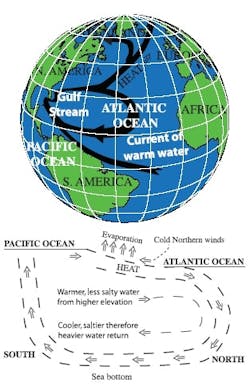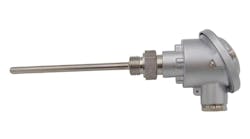By Béla Lipták, PE, CONTROL Columnist
SINCE THE times of Copernicus and Galileo, there has been conflict between the scientific and spiritual views of our existence. This “gap” seems to be closing today. We’re beginning to discover that there is a relationship between ethics and knowledge. For example, scientists have identified an area of the human brain where the intensity of electronic activity increases when we feel happy. Scientists have also measured that this electronic activity is increased by meditation, and therefore produces tranquility and happiness.
In this article, I don’t presume to deal with such weighty issues. And yet, I do hope to show that the knowledge we have accumulated in process control can be used to better understand and control some of the critical, non-industrial processes of our planet.
Global Heat Balance
Process control engineers know that before we can control a process, we have to understand it. This holds true for all processes, including the heat balance of a re-boiler or the Earth’s heat balance. In the discussion below, I will attempt to apply the analytical approach of a process control engineer to identify the variables, which mankind can manipulate to stabilize the presently out of control global heat balance.
The planet’s heat balance has been destabilized because its heat input is rising while its heat loss is dropping. Some models suggest that, by 2100, the annual temperatures in the Arctic regions of Russia, Canada and the U.S. will rise by up to 25 °F, and the planet’s ice-covered area will decrease from 13.3% to 4.8% of the land area, while the tundra will decline from 8% to 1.8%. Rising two miles high, the polar ice cap presently contains enough water to raise worldwide sea levels by 20 feet.
The global heat input has increased because some 500,000 square miles of Arctic ice (about twice the area of Texas) already have melted. This has increased the global heat input because the ice, which used to reflect the sun’s energy back into space, has been replaced by water, which absorbs the sun’s energy instead of reflecting it.
In addition, the planet’s heat loss is dropping because it’s better insulated than it was before. This new “overcoat” layer of thermal insulation was added by the accumulation of carbon dioxide and other greenhouse gases in the atmosphere. Popularly known as the greenhouse effect, this accumulation also prevents the sun’s energy from being reflected back into space. Drilling of the ice caps for core samples and analysis of the composition of the air bubbles trapped in them indicates that during the last 600,000 years, the CO2 concentration of our atmosphere has never been as high as it is today.
Presently, the concentration of atmospheric carbon dioxide is rising by 0.5% a year, and is predicted to double by 2070 and quadruple by 2160. During the 20th century, the carbon dioxide concentration of the atmosphere increased from 315 to 370 ppm and, as a result, the global temperature increased by 0.6 °C (1.1 °F). The various models developed to predict the trends for the 21st Century project a global temperature rise of 1.4 to 5.8 °C (2.5 to 10.5 °F).
This three-part article will describe how this temperature increase affects the formation of hurricanes and ocean currents, which are the great heat conveyors in the oceans, and will explain the interactions between oceanic and the atmospheric processes. This discussion will also cover the reasons why the melting of the ice caps are not only intensifying hurricanes, but also are making our winters in the North Atlantic region much colder. I will also show that once these aerodynamic and hydrodynamic processes have started, their flywheel effect (inertia) tends to keep them going.
We will see that the process of global warming, if allowed to continue, not only can cause the “temporization of the Arctic” region and the desertification of the American West, but also can result in a possible new ice age in Europe and in the eastern U.S. While this might sound like an alarmist overstatement to some, I would urge CONTROL’s readers to keep reading, and make judgments only after finishing the article.
The motors of the Great Heat Conveyor Belt are the Coriolis effect plus small temperature, salinity and elevation differences.
Heat Conveying Ocean Currents
The Great Heat Conveyor Belt (GHCB) transports thermal energy from the equator to the north, and thereby prevents development of another ice age in Europe. As this gigantic conveyor moves the heat to the North (See Figure 1 above), a smaller heat pump (the Gulf Stream) does the same on the East Coast of the U.S.
Three forces combine to drive the GHCB. The first is the Coriolis Effect, which is the consequence of the globe’s larger diameter near the equator than elsewhere, and of the resulting faster movement of the planet’s surface near the equator. The second is that the level of the Pacific Ocean is slightly higher than that of the Atlantic Ocean. The GHCB’s third driving force is the difference between the salinity and the temperature of the waters near the equator and near Greenland in the north.
Consequently, the oceans’ currents operate as follows: as the warm and relatively low-salinity (and therefore lighter) water from the equator travels north on the surface of the Atlantic, some of it evaporates, and this evaporation increases its salinity, making it heavier. As this water continues north, cold winds cool it, making it even heavier. Finally, near the coast of Greenland, it sinks down to the bottom of the Atlantic. Far larger than all of our planet’s rivers combined, this gigantic underwater river then travels south, warms, and becomes diluted. As its salinity decreases, its density drops, and it rises to the ocean’s surface in the Pacific, where it completes the loop.
The slowing of this heat conveyor and the reduced heat it transports to the North is already showing two of its effects: an increase in the intensity of hurricanes and an increase in the coldness of our winters. If this heat conveyor stops, our summers could permanently disappear. The dynamics of the GHCB is fast, it doesn’t take centuries, but only a few years for this conveyor to stop.
(Editor's Note: Part 2 of this article, "Can Process Control Help to Stabilize This Process," and Part 3, "Why Do We Have Global Warning," will appear in upcoming issues of CONTROL magazine and here on ControlGlobal.com.)
| About the Author |

Leaders relevant to this article:






